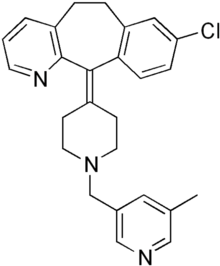Rupatadine
 | |
| Clinical data | |
|---|---|
| Trade names | Rupafin, Alergoliber, Rinialer, Pafinur, Rupax, Ralif, Rupanase |
| AHFS/Drugs.com | International Drug Names |
| Routes of administration | Oral |
| ATC code | R06AX28 (WHO) |
| Legal status | |
| Legal status |
|
| Pharmacokinetic data | |
| Protein binding | 98–99% |
| Metabolism | Hepatic, CYP-mediated |
| Biological half-life | 5.9 hours |
| Excretion | 34.6% urine, 60.9% faeces |
| Identifiers | |
| |
| CAS Number |
158876-82-5 182349-12-8 (fumarate) |
| PubChem (CID) | 133017 |
| ChemSpider |
117388 |
| UNII |
2AE8M83G3E |
| ChEMBL |
CHEMBL91397 |
| Chemical and physical data | |
| Formula | C26H26ClN3 |
| Molar mass | 415.958 g/mol |
| 3D model (Jmol) | Interactive image |
| |
| |
| | |
Rupatadine is a second generation antihistamine and PAF antagonist used to treat allergies. It was discovered and developed by J. Uriach y Cia, S. A.[1] and is marketed under several trade names such as Rupafin, Alergoliber, Rinialer, Pafinur, Rupax and Ralif.
Therapeutic indications approved
Rupatadine fumarate has been approved for the treatment of allergic rhinitis and chronic urticaria in adults and children over 12 years. The defined daily dose (DDD) is 10 mg orally.
Available form
Rupatadine is available as round, light salmon coloured tablets containing 10 mg of rupatadine (as fumarate) to be administered orally, once a day.
Side effects
Rupatadine is a non-sedating antihistamine. However, as in other non sedating second-generation antihistamines, the most common side effects in controlled clinical studies were somnolence, headaches and fatigue.
Mechanism of action
Rupatadine is a second generation, non-sedating, long-acting histamine antagonist with selective peripheral H1 receptor antagonist activity. It further blocks the receptors of the platelet-activating factor (PAF) according to in vitro and in vivo studies.[2]
Rupatadine possesses anti-allergic properties such as the inhibition of the degranulation of mast cells induced by immunological and non-immunological stimuli, and inhibition of the release of cytokines, particularly of the TNF in human mast cells and monocytes.[3]
Pharmacokinetics
Rupatadine has several active metabolites such as desloratadine, 3-hydroxydesloratadine, 6-hydroxydesloratadine and 5-hydroxydesloratadine.
History
Rupatadine discovery, pre-clinical and clinical development was performed by J. Uriach y Cia, S. A., a Spanish pharmaceutical company. It was launched in 2003 in Spain by J. Uriach y Cia, S. A., with the brand name of Rupafin. The registration of the product is approved in 23 countries from the EU, 8 Central American countries, Brazil, Argentina, Chile, Turkey and 14 African countries.
Efficacy in humans
The efficacy of rupatadine as treatment for allergic rhinitis (AR) and chronic idiopathic urticaria (CIU) has been investigated in adults and adolescents (aged over 12 years) in several controlled studies, showing a rapid onset of action and a good safety profile even in prolonged treatment periods of a year.[3][4][5]
References
- ↑ Patents: EP 577957, US 5407941, US 5476856
- ↑ Merlos, M.; Giral, M.; Balsa, D.; Ferrando, R.; Queralt, M.; Puigdemont, A.; García-Rafanell, J.; Forn, J. (1997). "Rupatadine, a new potent, orally active dual antagonist of histamine and platelet-activating factor (PAF)". The Journal of Pharmacology and Experimental Therapeutics. 280 (1): 114–121. PMID 8996188.
- 1 2 Picado, C. S. (2006). "Rupatadine: Pharmacological profile and its use in the treatment of allergic disorders". Expert Opinion on Pharmacotherapy. 7 (14): 1989–2001. doi:10.1517/14656566.7.14.1989. PMID 17020424.
- ↑ Keam, S. J.; Plosker, G. L. (2007). "Rupatadine: A review of its use in the management of allergic disorders". Drugs. 67 (3): 457–474. doi:10.2165/00003495-200767030-00008. PMID 17335300.
- ↑ Mullol, J.; Bousquet, J.; Bachert, C.; Canonica, W. G.; Gimenez-Arnau, A.; Kowalski, M. L.; Martí-Guadaño, E.; Maurer, M.; Picado, C.; Scadding, G.; Van Cauwenberge, P. (2008). "Rupatadine in allergic rhinitis and chronic urticaria". Allergy. 63: 5–28. doi:10.1111/j.1398-9995.2008.01640.x. PMID 18339040.